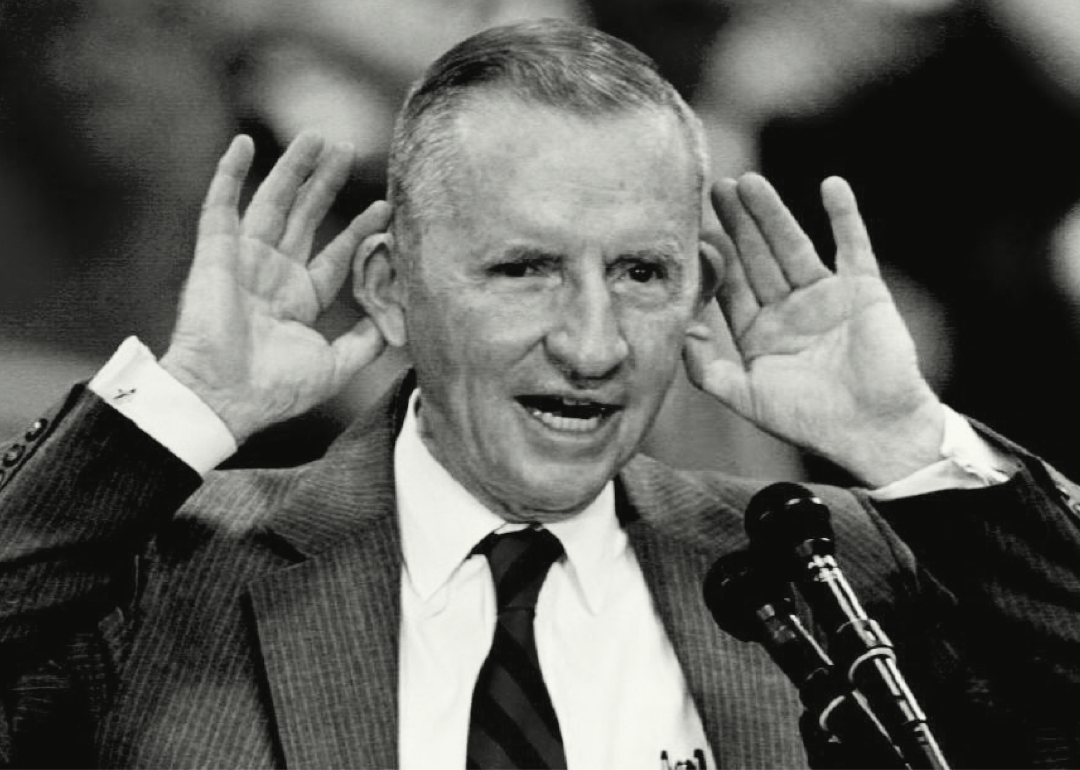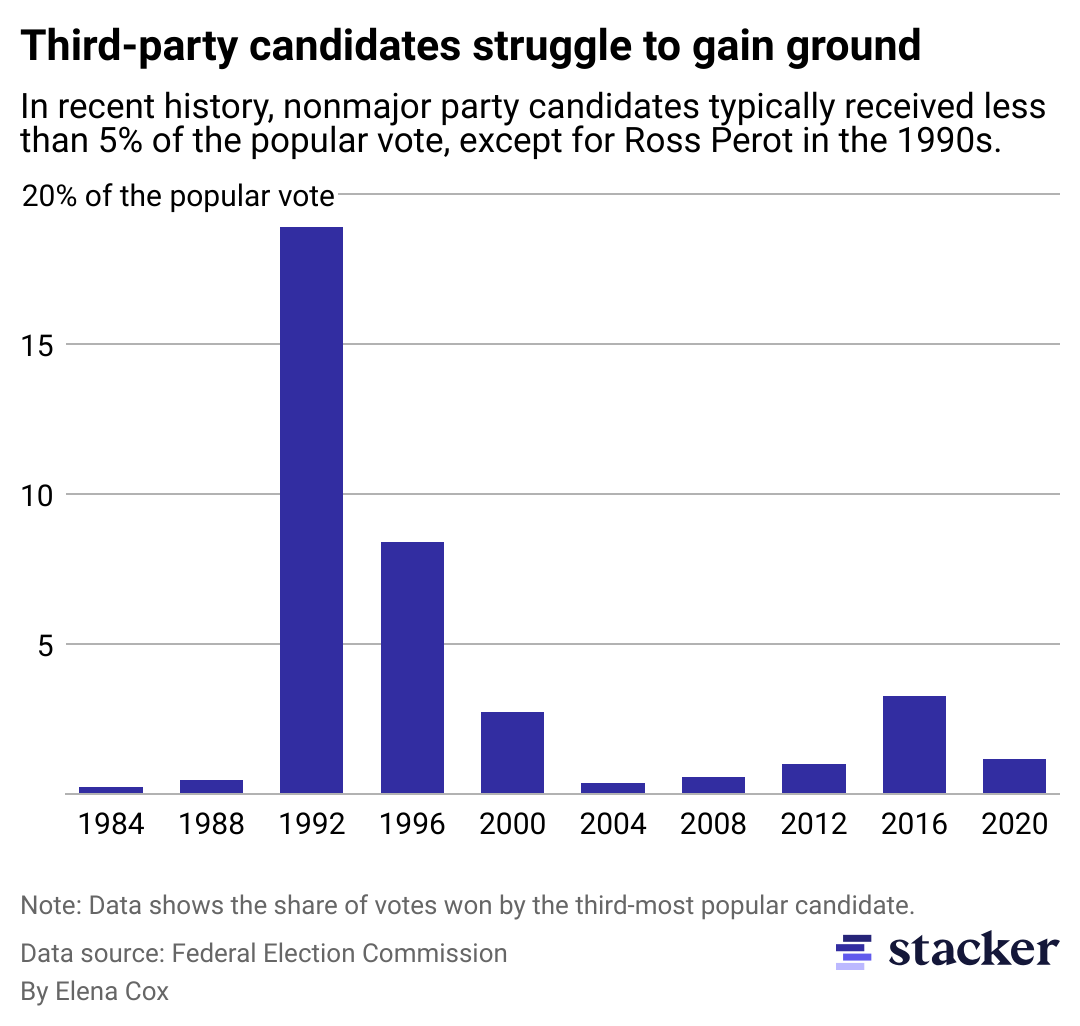
History of third-party votes in US presidential elections
History of third-party votes in US presidential elections
As Election Day rapidly approaches, the presidential race between Vice President Kamala Harris and former President Donald Trump is in a dead heat. National polling averages as of late October show Harris roughly 1.4 percentage points above Trump. As of Oct. 29, the two are tied in several key battleground states, including Georgia and Wisconsin.
At least three independent and third-party candidates remain in the race, too. Though these options vary by state, many ballots will feature Justice for All candidate Cornel West, polling at less than 1% nationally; Libertarian candidate Chase Oliver, with around 1% support; and third-time Green Party candidate Jill Stein, who is fending off ballot challenges from the Democratic Party and accusations that her campaign is a vote spoiler, polling at about 1% as of late September.
Third-party candidates have appeared throughout the history of American politics, though most have been unable to challenge the dominance of the two-party system in a meaningful way. Stacker examined data from the Federal Election Commission, Pew Research Center, and other sources to explore the history of third-party candidates in U.S. presidential elections.
In 1892, Populist Party candidate James B. Weaver, fueled by farmers' discontent, captured about 9% of the vote, demonstrating the potential of third-party movements.
Teddy Roosevelt's "Bull Moose" campaign in 1912 saw a former president defect from his party. Having just lost the Republican nomination to incumbent William Howard Taft, Roosevelt led the progressive faction of the party to form a new one and run in the general election. While he ultimately failed to win, he took about 27% of the popular vote and 88 electoral votes with him: the largest share of any third-party presidential campaign in American history. The split in Republican votes helped deliver victory to Democrat Woodrow Wilson.
Since then, many third parties have vied for the presidency. None have exceeded Roosevelt's percentage of votes in 1912.
The mid-20th century saw the emergence of parties rooted in regional and ideological divides. George Wallace's segregationist American Independent Party captured 13.5% of the vote in 1968, while Ross Perot's 1992 Independent run, driven by economic concerns, earned 19%.
More recently, foreign influence has added a new layer to third-party dynamics. Russia has been accused of using election interference tactics to support third-party candidates as a means of weakening major party contenders. Russian operatives during the 2016 election cycle attempted to boost Green Party candidate Jill Stein through social media campaigns and misinformation efforts, aiming to siphon votes from Democratic nominee Hillary Clinton, according to reports released by the Senate Intelligence Committee.
During the 2024 election cycle, Robert F. Kennedy Jr. challenged President Joe Biden in the Democratic primary but eventually withdrew from the contest to campaign as an Independent in the general election. Just before Biden himself dropped out of the race on July 21, Kennedy was polling in the double digits in some national polls.
Once Vice President Kamala Harris replaced Biden at the top of the Democratic ticket, Kennedy's support plummeted. By the time he dropped out on Aug. 23 and endorsed former President Donald Trump, Kennedy was polling as low as 5%.
Before the presidential race reset after Biden dropped out and Harris accepted the Democratic nomination, Trump was up 3.2 percentage points. By July 24, the race between the Democratic and Republican nominees was neck and neck, with Harris and Trump essentially tied and Kennedy at 5.2%, according to national polling averages tabulated by ABC News.
The momentum continued to build for the new Harris ticket while Trump slumped and Kennedy faded. By the last night of the DNC, Harris had risen to 47.2%, Trump was down to 43.6%, and Kennedy—who dropped out the following day—was down to 4.7%.

Third-party candidates face an uphill battle
Most third-party candidates in the last 40 years have been unable to muster more than 5% of the popular vote. In 1992 and 1996, Independent candidate Ross Perot bucked the trend and got 18.9% and 8.4%, respectively.
A billionaire tech entrepreneur, Perot took his fiscally conservative and socially moderate message directly to viewers in extended infomercials he purchased on major TV networks. His straight-talking and pragmatic style, often illustrated with charts, appealed to middle-class voters. After getting nearly 19% of the popular vote in his first run (although with no electoral votes), he met the threshold to qualify for federal funding when he ran again in 1996.
Requirements for appearing on state ballots and meeting the thresholds for participation in nationally televised presidential debates represent massive hurdles for candidates operating outside the dominant two-party system. Strategic voting appeals by major parties and relentless media scrutiny also contribute to an overall dropoff in third-party support.
While third-party bids from the likes of Reform Party candidate Jesse Ventura in 1998 (as Minnesota governor) and Green Party candidate Ralph Nader in 2000 found varying degrees of success, the campaigns struggled to sustain momentum as Election Day approached. In Nader's case, however, his 97,000 votes in Florida were enough for Democrats to blame him for Bush's official victory there. Bush's razor-thin margin in that state was enough to make him president amid a recount halted by the Supreme Court.

Calls to expand beyond the two-party system grow
Despite the lack of support in national polls, many Americans look favorably upon the idea of having more political parties. Over a third want more parties to choose from, per Pew, while voter dissatisfaction with the current political status quo is at a three-decade high.
Still, third-party candidates face a difficult climb to get on the ballot, often requiring thousands of signatures and navigating complex state rules. Many have argued that voting third-party only serves to "waste" votes and potentially spoil a race. But FEC guidelines grant candidates partial public funding if a candidate gets at least 5% of the national vote, which could set them up for stronger future runs.
Some critics argue that the entrenched two-party system stifles competition and voter choice and is rigged in favor of the governing parties, fueling growing calls to reform or even abolish it in favor of a more inclusive, multiparty democracy.
In his 1796 Farewell Address, President George Washington cautioned against the rise of political parties and factionalism that could "become potent engines by which cunning, ambitious, and unprincipled men will be enabled to subvert the power of the people and to usurp for themselves the reins of government."
Whether that problem should be addressed by more parties—or fewer—is for voters to decide at the ballot box.
Story editing by Tim Bruns. Additional editing by Nicole Caldwell. Copy editing by Kristen Wegrzyn.
This article is part of U.S. Democracy Day, a nationwide collaborative on Sept. 15, the International Day of Democracy, in which news organizations cover how democracy works and the threats it faces. To learn more, visit usdemocracyday.org.



